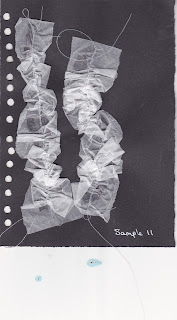Fig. 2.1
Fig. 2.2
Fig. 2.3
Fig. 2.4
The labels on these scrunched up papers are hidden so reading left to right:
Top row: card; newsprint; lining paper
Centre: wrapping paper; kitchen roll; tissue
Bottom row: hand-made tissue; silk paper; architects tracing paper
Fig. 2.5
Sample 1: Tissue paper hole punched with an oblong punch, then torn and layered
Fig. 2.6
Sample 2: Tracing paper strips cut with scallop edged scissors and overlapped
Fig. 2.7
Sample 3: Tracing paper cut with different scrapbooking scissors, patches and strips overlapped
Fig. 2.8
Sample 4: Tracing paper run through the sewing machine without thread then torn into strips and overlapped
Fig. 2.9
Sample 5: Pleated tissue paper strips and patches
Fig. 2.10
Sample 6: Tissue paper pleated in two directions
Fig. 2.11
Sample 7: Scrunched tissue paper glued down to retain rough folds.
Fig. 2.12
Sample 8: Rolled and twisted strips of tissue paper
Fig. 2.13
Sample 9: Tissue paper strips rolled and knotted
Fig. 2.14
Sample 10: Strip of tissue paper machine gathered along one edge and formed into a rough circle
Fig. 2.15
Sample 11: Long strips of tissue paper machine gathered roughly down the centre and glued in place
Fig. 2.16
Sample 12: A large piece of tissue paper with four rows of machine stitch to gather up before gluing in place.
Some of these initial samples I think are already suggesting the textures on my trees but I'll play with them more in the next chapter.
















No comments:
Post a Comment